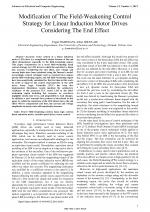| 3/2015 - 1 | View TOC | « Previous Article | Next Article » |
Modification of The Field-Weakening Control Strategy for Linear Induction Motor Drives Considering The End EffectHAMEDANI, P. |
| Extra paper information in |
| Click to see author's profile in |
| Download PDF |
Author keywords
field-weakening control, fuzzy logic control, linear induction motor, variable speed drives, vector control
References keywords
induction(17), control(15), field(11), weakening(8), region(8), power(7), motor(7), machine(7), electronics(6), applications(5)
Blue keywords are present in both the references section and the paper title.
About this article
Date of Publication: 2015-08-31
Volume 15, Issue 3, Year 2015, On page(s): 3 - 12
ISSN: 1582-7445, e-ISSN: 1844-7600
Digital Object Identifier: 10.4316/AECE.2015.03001
Web of Science Accession Number: 000360171500001
SCOPUS ID: 84940768901
Abstract
Accurate vector control of a linear induction motor (LIM) drive is a complicated subject because of the end effect phenomenon especially in the field-weakening region. This paper concentrates on a novel field-weakening speed control strategy for LIM drive in which the end effect is taken into account. Considering the end effect, new voltage and current limits have been calculated using the Duncan's model. Accordingly, control strategies such as constant force region, partial field-weakening region, and full field-weakening region have been analytically calculated for the first time in this work. In order to improve the control characteristics of the LIM drive, Fuzzy Logic Controller (FLC) has been also implemented. Simulation results manifest the satisfactory resultants of the proposed FLC based LIM in the field-weakening region including fast response, no overshoot, negligible steady-state error, and adaptability to load changes. In addition, a new constant force pattern is introduced in this paper by which the reductions of the LIM thrust due to the end effect will be compensated and thus, the current and voltage amplitudes in steady state will remarkably decrease. |
| References | | | Cited By |
Web of Science® Times Cited: 2 [View]
View record in Web of Science® [View]
View Related Records® [View]
Updated 2 weeks, 6 days ago
SCOPUS® Times Cited: 3
View record in SCOPUS® [Free preview]
View citations in SCOPUS® [Free preview]
[1] Adaptive Robust Motion Control for Linear Induction Motor with Electromagnetic Nonlinearity Compensation, Lu, Linlin, Sun, Peng, Xu, Linsen, Luo, Minzhou, Asian Journal of Control, ISSN 1561-8625, Issue 5, Volume 21, 2019.
Digital Object Identifier: 10.1002/asjc.1843 [CrossRef]
[2] Adaptive Robust Position/Thrust Tracking Control of Linear Induction Motor with Unknown End-Effect, Lu, Linlin, Sun, Pengo, IECON 2018 - 44th Annual Conference of the IEEE Industrial Electronics Society, ISBN 978-1-5090-6684-1, 2018.
Digital Object Identifier: 10.1109/IECON.2018.8591143 [CrossRef]
Disclaimer: All information displayed above was retrieved by using remote connections to respective databases. For the best user experience, we update all data by using background processes, and use caches in order to reduce the load on the servers we retrieve the information from. As we have no control on the availability of the database servers and sometimes the Internet connectivity may be affected, we do not guarantee the information is correct or complete. For the most accurate data, please always consult the database sites directly. Some external links require authentication or an institutional subscription.
Web of Science® is a registered trademark of Clarivate Analytics, Scopus® is a registered trademark of Elsevier B.V., other product names, company names, brand names, trademarks and logos are the property of their respective owners.
Faculty of Electrical Engineering and Computer Science
Stefan cel Mare University of Suceava, Romania
All rights reserved: Advances in Electrical and Computer Engineering is a registered trademark of the Stefan cel Mare University of Suceava. No part of this publication may be reproduced, stored in a retrieval system, photocopied, recorded or archived, without the written permission from the Editor. When authors submit their papers for publication, they agree that the copyright for their article be transferred to the Faculty of Electrical Engineering and Computer Science, Stefan cel Mare University of Suceava, Romania, if and only if the articles are accepted for publication. The copyright covers the exclusive rights to reproduce and distribute the article, including reprints and translations.
Permission for other use: The copyright owner's consent does not extend to copying for general distribution, for promotion, for creating new works, or for resale. Specific written permission must be obtained from the Editor for such copying. Direct linking to files hosted on this website is strictly prohibited.
Disclaimer: Whilst every effort is made by the publishers and editorial board to see that no inaccurate or misleading data, opinions or statements appear in this journal, they wish to make it clear that all information and opinions formulated in the articles, as well as linguistic accuracy, are the sole responsibility of the author.



